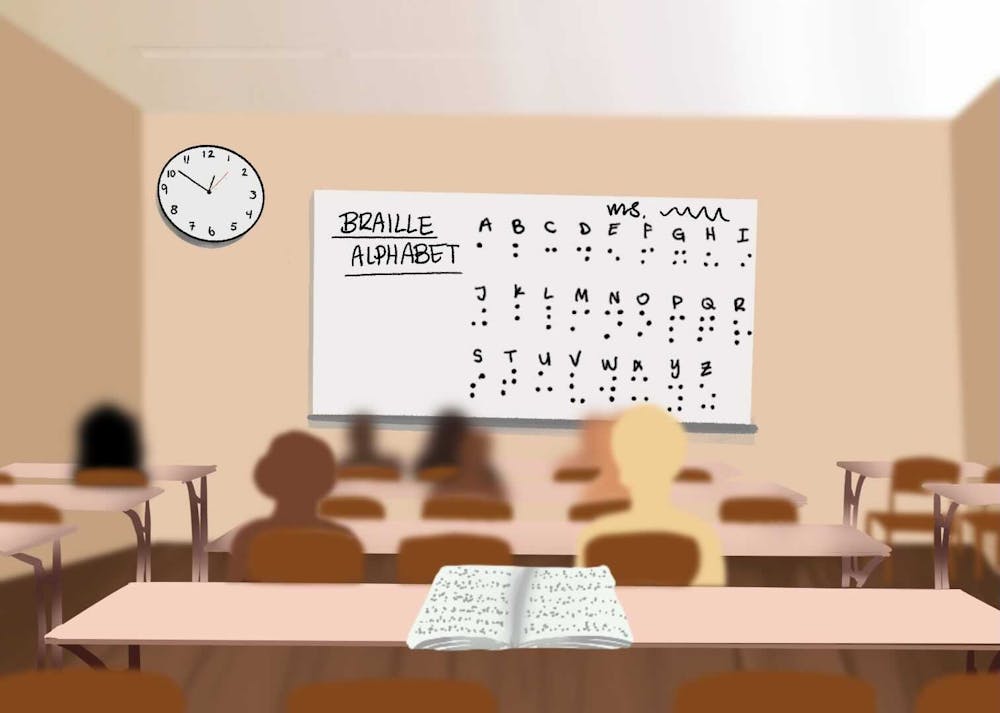Three ASU students are working together to build a better future for students who are visually impaired and provide them with a better classroom experience.
The system the students created, EquiBraille, uses artificial intelligence to produce real-time notes for visually impaired students. The program uses the camera that classrooms already have and feeds it onto the braille board that the visually impaired students would have.
Krishna Prasad Sheshadri, a graduate student studying computer science and one of the creators of EquiBraille, wanted to work on this project because he noticed what visually impaired students have been missing out on.
"The idea was everything should happen in real time so they get an experience like every other student," Sheshadri said. "We want the students sitting there to feel like they're going along with the class like everyone else."
Sheshadri worked on the project with partners Keval Shahand Ananya Yadav, both sophomores studying computer science, who bonded on their past experience of working with visually impaired students while living in India.
"I always felt like there was a gap between the way they're understanding things and the way the (hearing) student understands things, the reason being that it is very hard to understand certain subjects with just the audio transcription," Shah said. "I thought, what if we can make a product which can actually do that in real time so that a blind student won't have to rely on anyone to actually understand what's happening in the class?"
The three students joined a hackathon in February of 2022 at ASU, hosted by Learning Futures. Hackathons are social coding events intended to bring together computer programmers to improve upon or build a new software program.
At the event, the students learned what Verizon 5G could be used to solve real world scenarios. Using their past experience, they wanted to see if they could use this technology to help visually impaired or blind students have a better learning experience.
"There aren't enough resources that are bridging the gap between how lectures are being taught and how course material is available for visually impaired students," Sheshadri said. "That's when we were like, 'Can we use some state of the art technology to actually solve this?'"
Learning Futures is a program that works with colleges all over the country in the enterprise technology office, which helps with the technology needs of universities. Dan Munnerley, executive director of Learning Futures, talked about how they help students interested in technology.
"Learning Futures is a group that looks to the future. We look out at the three-to-five year horizon and we try to figure out what the future of learning should look like, and then start building proof of concepts and prototypes now that help us get there quicker," Munnerley said.
After COVID-19, most classrooms had cameras added that helped the group when making the EquiBraille technology. The team was worried about how long it would take for the information that was written on the board to get translated into braille, but the 5G technology helped speed up the process.
The team ended up winning the hackathon and earning a grant, which got them an internship with Venture Capital and Clinton Global Initiative. The internship helped them focus on the entrepreneurial side of the business so they can learn how to grow and market their product.
"They provided help and impetus to how we could grow this business and what kind of strategies we would apply to expand our business," Sheshadri said.
Although the project is not yet finished, the team hopes to have it done soon so they are able to test it out in ASU classrooms with students who are blind or visually impaired.
Edited by Andrea Ramirez, Sadie Buggle, Reagan Priest, Sophia Balasubramanian and Caera Learmonth.
Reach the reporter at mtvega1@asu.edu and follow @madivega18 on Twitter.
Like The State Press on Facebook and follow @statepress on Twitter.




